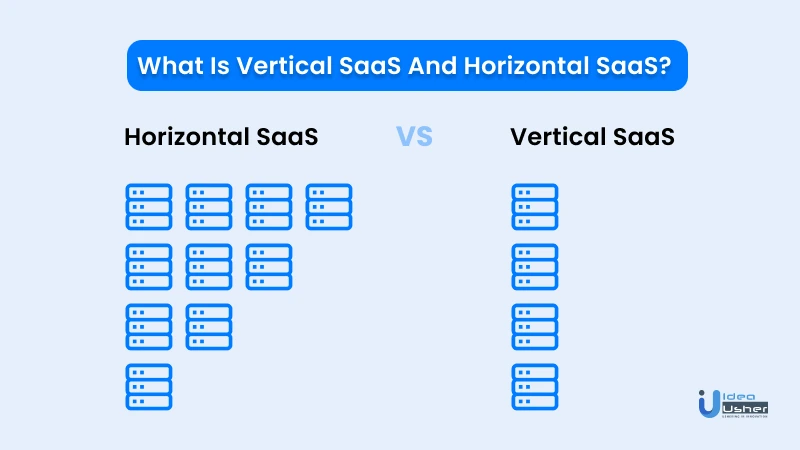SaaS is a very dynamic field with new trends showing up frequently. One such trend you will encounter in the next few years is the growth of vertical SaaS platforms. It can be a great opportunity for your startup company.
But going the vertical SaaS route does have its own challenges that you need to overcome. Let’s take a dive into how you can succeed in this effort and rise up the vertical SaaS hierarchy.
Understanding Vertical SaaS
So, what is vertical SaaS exactly?. In its simplest definition, it is a software service that focuses on a specific niche or industry. All the aspects of the service work as such that the service covers all aspects of the operations of that niche or industry.
Differentiating Vertical And Horizontal SaaS
Obviously, with a name like vertical SaaS, this type of service has a horizontal counterpart. This service is one that caters to a wide variety of industries. They focus on a specific business process or aspect common across these niches. Beyond the orientation, there are several other key differences between the two.

Market size.
Because vertical SaaS focuses only on a specific niche or industry, it has a smaller market size than the horizontal one. However, vertical SaaS companies can generate a relatively larger revenue from each customer due to a broader scope of services. That difference in scope results in differing approaches in marketing products.
Competition
The horizontal SaaS market is often crowded due to competition for the same customers. Since clients have many options, these companies need to stay at the top of their game. They also often have to face different fronts in their business.
With vertical SaaS, you have fewer competitors in your chosen niche. However, it can still get more involved. Here, your goal is to forge a more long-term relationship with clients. That ensures that you can keep up with their needs.
Why SaaS Your Startup Company Should Go Vertical
Of course, the horizontal SaaS model is as valid as the vertical one. But you might wonder why going with the latter would be the better option for your business. Here are some of the reasons to choose this direction.
Higher Returns In Investment

Seeing that you will be dealing with clients in a more involved manner, you can also expect a greater revenue from each of them. Additionally, since you are dealing with fewer clients, it is easier to do marketing studies for them. That gives you better opportunities to secure and maintain their interest in your service.
Better Product Fit
Before establishing your startup company, you already have a product concept. However, to really get most out of that concept, you need it to hit the right target market. And sometimes, you won’t find that in the horizontal setup. Going vertical will let you hone that market and deliver a more effective product experience.
More Effective Upgrade And Scaling Cycle
Another essential area when running a SaaS service is providing continuing upgrades to it. With vertical SaaS, doing this is easy. Since you only deal with a very specific market, you can better determine what upgrades to make. Scaling up the product is also a lot easier since you deal only with fewer company ecosystems.
Preparing Your Startup Company For Vertical SaaS
It is interesting to note that most vertical SaaS firms actually start from the horizontal model. That is because they are still figuring out the ideal customers for their products. Once they find that out, then the transition begins. So, how do you get ready for that move?
Understanding The Market
To better penetrate the market your startup company will focus on, you should understand it more. That is where you deepen the initial market research that you have done before. One area to focus here is understanding the industry pain points.

Note that you don’t just focus on those pain points your service directly addresses. You also need to know other potential issues that your customers deal with. That will help you determine any future upgrades you want to introduce to the service. Talk to different industry experts to better grasp these pain points. You will have to do this frequently to be on top of the latest issues of concern.
Understanding Industry-Specific Compliance Tools
Another area you want to get into when transitioning to vertical SaaS is understanding the various compliance requirements. This part is crucial, as you want to offer services that already have these compliances built in. The strategy can help you convince potential clients to switch to you from horizontal services.

Virtua Solutions will help you map out all of these compliance concerns. We do the research for you, helping you get all of the information you need regarding them. Our team will also assist in compliance documentation to ensure everything is on the right track.
Building The Needed Support Environment
Vertical SaaS requires a more involved customer support system than its horizontal counterpart. After all, you will support every aspect of the client’s use of your service. As such, you want this support system set up early on.
Virtua Solutions is ready to help you in developing that infrastructure. Our main work would be providing the customer service team you might need. We can fully customize the team based on the type of customer service you need.

For instance, you can have our team take either the main or auxiliary support role. Depending on your chosen option, we will determine the size and composition of the team. Each agent is trained to handle a variety of customer service duties. We can also hire agents that have more specializations you might need.
Beyond the customer-facing work, Virtua Solutions can also help you with other support duties. Maintaining customer information infrastructures is one such area that we work in. Our team will help you build knowledge bases and other online resources for your customers and internal teams. From there, we work on maintaining these to ensure they match your changing needs.
Time For Your SaaS Startup Company To Go UP With Our Help
Of course, transitioning to the vertical SaaS model is just a start. Once you make the jump, there are more things that you have to do to succeed. Luckily, we at Virtua Solutions have your back. Get in touch with us and let’s talk more about how you can succeed in this new venture.
